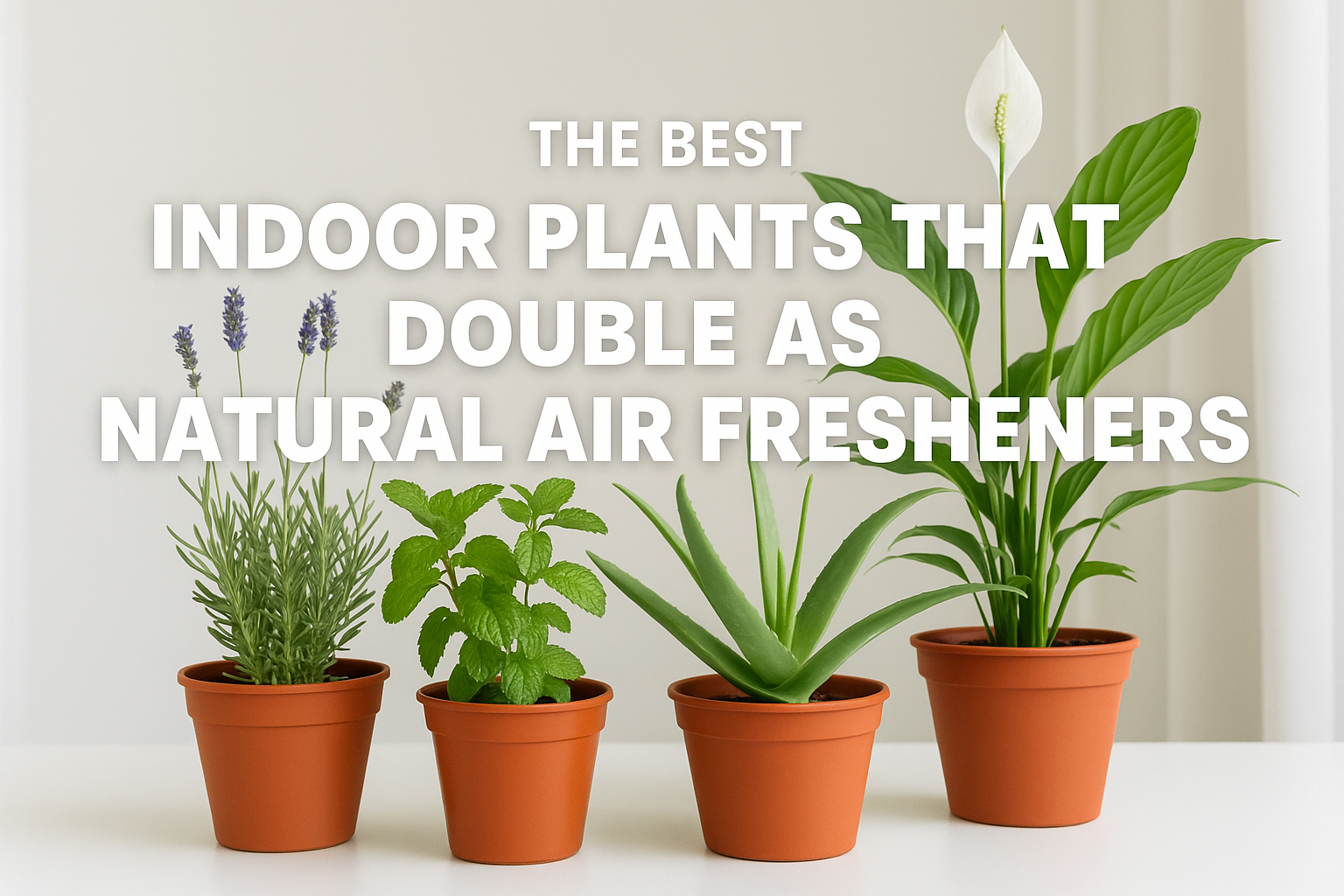Indoor air quality affects both health and comfort. Many people turn to sprays, candles, or plug-ins to improve the atmosphere of their homes.
Yet, nature already provides a beautiful solution. Certain indoor plants not only decorate spaces but also purify the air and release natural fragrances.
By choosing the right plants, you can enjoy fresh, clean air without relying on synthetic products. These living air fresheners are sustainable, eco-friendly, and deeply connected to traditional wisdom.
Why Indoor Plants Improve Air Quality
Plants naturally absorb carbon dioxide and release oxygen through photosynthesis. Many also filter harmful toxins, such as formaldehyde, benzene, and trichloroethylene, which are common in household materials.
At the same time, fragrant plants release subtle aromas that enhance mood and create a welcoming environment. Their benefits go beyond decoration, turning them into functional members of the household.
Lavender: A Natural Relaxant
Lavender is a classic indoor plant loved for its calming scent. Its flowers emit a gentle fragrance that promotes relaxation and better sleep. Placed in bedrooms, lavender can help reduce stress after long days.
In addition to its aroma, lavender adds a splash of color and charm to windowsills and small pots. It thrives in sunny spots and requires minimal care when watered moderately.
Rosemary: Sharp and Refreshing
Rosemary brings both beauty and function to indoor spaces. Its strong, herbal fragrance refreshes rooms and sharpens focus, making it an excellent choice for home offices.
Gaúcho traditions also connect rosemary with protection and cleansing. Indoors, it doubles as a culinary herb, always available for cooking while purifying the air naturally.
Mint: Cool and Invigorating
Mint spreads easily, making it a reliable indoor plant. Its cool aroma freshens kitchens, bathrooms, and living rooms. When touched, mint leaves release an instant burst of fragrance.
Mint grows best in containers to prevent overgrowth. Regular trimming ensures healthy leaves while keeping the scent active throughout the home.
Lemon Balm: Gentle Citrus Comfort
Lemon balm carries a delicate citrus scent that soothes nerves and uplifts spirits. As an indoor plant, it works well in bedrooms, kitchens, and quiet corners of the house.
Its fragrance is subtle yet persistent, offering comfort without overwhelming the senses. Families often brew lemon balm into teas, reinforcing its role as both a calming herb and an air freshener.
Geranium: Floral and Versatile
Scented geraniums, available in varieties such as rose, lemon, or mint, are prized for their wide range of fragrances. Their leaves release aroma when brushed, filling rooms with freshness.
Geraniums adapt well to pots and brighten spaces with colorful flowers. Their versatility makes them one of the most beloved dual-purpose indoor plants.
Jasmine: Exotic and Sweet
Jasmine is valued for its intoxicatingly sweet aroma. As a climbing indoor plant, it adds elegance to windows and balconies. Its fragrance is strongest in the evening, creating a soothing atmosphere for relaxation.
Jasmine requires sunlight and consistent care but rewards homes with both beauty and natural perfume. It remains one of the most powerful natural air fresheners.
Peace Lily: Clean and Elegant
Peace lilies are not strongly scented, but they excel at purifying air. Their elegant white blooms and lush leaves absorb toxins and add humidity to rooms.
For households sensitive to strong scents, peace lilies offer a subtler form of freshness. They bring visual calm and balance while improving indoor air quality.
Gardenia: Classic and Luxurious
Gardenias are treasured for their creamy white flowers and rich, intoxicating fragrance. They add luxury to any room while functioning as natural air fresheners.
Though gardenias require more care, including proper humidity and light, their rewards are unmatched. A single blooming plant can perfume an entire space.
Orchids: Delicate and Modern
Certain orchid varieties, such as vanilla orchids, release soft fragrances. Even unscented orchids contribute indirectly by improving air circulation and adding beauty.
Orchids symbolize elegance and are easy to integrate into modern home décor. Their delicate presence enhances both visual and sensory aspects of a room.
Aloe Vera: Subtle but Powerful
Aloe vera is not strongly aromatic but deserves a place on this list for its air-cleaning abilities. It absorbs toxins and contributes oxygen at night, making it suitable for bedrooms.
Its gel-filled leaves also provide natural skincare remedies. Aloe represents the blend of functionality and sustainability in indoor living.
How to Care for Indoor Air-Freshening Plants
To maximize benefits, plants need proper care:
- Place them in areas with sufficient light.
- Water according to species needs, avoiding both dryness and overwatering.
- Trim leaves and flowers regularly to encourage growth.
- Rotate plants so all sides receive sunlight.
Caring for plants not only preserves fragrance but also creates a sense of mindfulness in daily routines.
Combining Plants for Layered Fragrance
Using multiple plants together creates a layered natural fragrance. For example, lavender and rosemary combine relaxation with sharp freshness, while mint and lemon balm provide a cooling citrus blend.
Strategically placing different plants in various rooms ensures each space has its own atmosphere, from calming bedrooms to energizing kitchens.
Plants in Gaúcho Tradition
In Gaúcho households, plants like rosemary and marcela carried symbolic meaning beyond their aroma. Rosemary, placed near doors, was believed to protect the home, while marcela was dried and stored for spiritual and practical use.
Bringing plants indoors continues this tradition, linking cultural heritage with modern eco-friendly practices.
The Wellness Benefits of Indoor Plants
Studies confirm that indoor plants reduce stress, improve concentration, and increase feelings of well-being. Their natural fragrance enhances these effects by creating pleasant environments.
Unlike synthetic products, plants work continuously and sustainably, supporting both health and mood in subtle ways.
Eco-Friendly Advantages
Relying on plants for fragrance eliminates the need for disposable sprays and chemical products. Plants are renewable, biodegradable, and beneficial for the environment.
By choosing them, households reduce waste and embrace zero-waste living practices aligned with sustainable lifestyles.
Mistakes to Avoid
To keep plants thriving, avoid:
- Overwatering, which can cause root rot.
- Using heavy fertilizers that affect natural fragrance.
- Placing plants in dark corners without sufficient light.
Mindful care ensures plants remain healthy and effective as natural air fresheners.
Final Thoughts
Indoor plants are more than decorative objects. They are living allies that refresh air, add fragrance, and improve well-being. From lavender’s calming presence to jasmine’s sweet perfume, each plant brings unique qualities into the home.
By choosing the right mix of plants, you create a sustainable, beautiful, and naturally fragrant environment. These green companions prove that nature offers the best air fresheners, balancing tradition, health, and modern eco-conscious living.

Marcela Cardozo is passionate about Southern Brazilian traditions and the cultural stories carried through natural scents. She blends knowledge of native herbs, essential oils, and regional rituals to create practical and inspiring content. Her writing connects ancestral wisdom with modern living, offering readers simple ways to bring authenticity, well-being, and meaning into their everyday lives.
